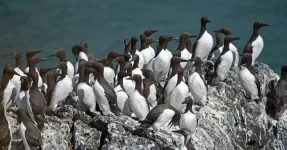(Press-News.org) A genomic study encompassing more than 300 genomes spanning the last 50,000 years has revealed how a single wave of Neandertal gene flow into early modern humans left an indelible mark on human evolution. Among other findings, the study reports that modern humans acquired several Neanderthal genes that ended up being advantageous to our lineage, including those involved in skin pigmentation, immune response, and metabolism. To date, sequencing of Neanderthal and Denisovan genomes has revealed substantial gene flow between these archaic hominins and modern human ancestors, even as scientists have also reported that Neanderthal ancestry is unevenly distributed across the genome. Moreover, certain regions of the genome – known as archaic deserts – completely lack Neandertal ancestry, while others exhibit high frequencies of Neanderthal variants, potentially due to beneficial adaptive mutations. However, much about the nature of this ancient admixture, including the role evolutionary forces like genetic drift or natural selection played in shaping these patterns, remains unclear. Using genomic data from 334 modern humans, including 59 ancient individuals ranging from 45,000 to 2,200 years old, and 275 present-day individuals from diverse global populations, Leonardo Iasi et al. performed a comprehensive evaluation of Neanderthal ancestry variation in modern humans over the last ~50,000 years. Iasi et al. discovered that the vast majority of Neanderthal gene flow is attributable to a single, shared extended period of gene flow that likely occurred 50,500 to 43,500 years ago, which is consistent with archeological evidence for the overlap of modern humans and Neandertals in Europe. Additionally, the findings demonstrate that Neanderthal ancestry underwent rapid natural selection – both positive and negative – within 100 generations after gene flow, especially on the X chromosome.
Nature is publishing a related paper, “Earliest modern human genomes constrain timing of Neanderthal admixture,” embargoed for the same time (Thursday, 12 December at 2pm US ET). To obtain a copy of this paper, please email press@nature.com or visit the Springer Nature press site. An online press briefing for the two papers will take place UNDER STRICT EMBARGO on Wednesday at 3pm London time (GMT) / 10 am US Eastern Time. To attend this briefing please pre-register here.
END
Genomic analysis refines timing of Neandertal admixture – and its impact on modern humans
Summary author: Walter Beckwith
2024-12-12
ELSE PRESS RELEASES FROM THIS DATE:
Superflares once per century
2024-12-12
There is no question that the Sun is a temperamental star, as alone this year’s unusually strong solar storms prove. Some of them led to remarkable auroras even at low latitudes. But can our star become even more furious? Evidence of the most violent solar “tantrums” can be found in prehistoric tree trunks and in samples of millennia-old glacial ice. However, from these indirect sources, the frequency of superflares cannot be determined. And direct measurements of the amount of radiation reaching the Earth from the Sun have only been available since the ...
A new timeline for Neanderthal interbreeding with modern humans
2024-12-12
A new analysis of DNA from ancient modern humans (Homo sapiens) in Europe and Asia has determined, more precisely than ever, the time period during which Neanderthals interbred with modern humans, starting about 50,500 years ago and lasting about 7,000 years — until Neanderthals began to disappear.
That interbreeding left Eurasians with many genes inherited from our Neanderthal ancestors, which in total make up between 1% and 2% of our genomes today.
The genome-based estimate is consistent with archeological evidence that modern humans and Neanderthals lived side-by-side in Eurasia for between 6,000 and 7,000 years. The analysis, which involved present-day human genomes ...
New timeline for Neandertal gene flow event
2024-12-12
The study of ancient DNA has greatly advanced our knowledge of human evolution, including the discovery of gene flow from Neandertals into the common ancestors of modern humans. Neandertals and modern humans diverged about 500,000 years ago, with Neandertals living in Eurasia for the past 300,000 years. Then, sometime around 40,000 to 60,000 years ago, modern human groups left Africa and spread across Eurasia, encountering Neandertals along the way. As a result, most non-Africans harbor one to two percent ...
Your immune cells are what they eat
2024-12-12
LA JOLLA (December 12, 2024)—The decision between scrambled eggs or an apple for breakfast probably won’t make or break your day. However, for your cells, a decision between similar microscopic nutrients could determine their entire identity. If and how nutrient preference impacts cell identity has been a longstanding mystery for scientists—until a team of Salk Institute immunologists revealed a novel framework for the complicated relationship between nutrition and cell identity.
The answers came while the researchers ...
Oldest modern human genomes sequenced
2024-12-12
After modern humans left Africa, they met and interbred with Neandertals, resulting in around two to three percent Neandertal DNA that can be found in the genomes of all people outside Africa today. However, little is known about the genetics of these first pioneers in Europe and the timing of the Neandertal admixture with non-Africans.
A key site in Europe is Zlatý kůň in Czechia, where a complete skull from a single individual who lived around 45,000 years ago was discovered and previously ...
Diverse virus populations coexist on single strains of gut bacteria
2024-12-12
Viruses that infect and kill bacteria, called phages, hold promise as new treatment types for dangerous infections, including strains that have become resistant to antibiotics. Yet, virologists know little about how phages persist in the populations of bacterial cells they infect, hampering the development of phage therapies.
Published online December 13 in the journal Science, a new study offers the first evidence that a single bacterial species, the host of a phage, can maintain a diverse community of competing phage species. Led by researchers at NYU Grossman ...
Surveys show full scale of massive die-off of common murres following the ‘warm blob’ in the Pacific Ocean
2024-12-12
Murres, a common seabird, look a little like flying penguins. These stout, tuxedo-styled birds dive and swim in the ocean to eat small fish and then fly back to islands or coastal cliffs where they nest in large colonies. But their hardy physiques disguise how vulnerable these birds are to changing ocean conditions.
A University of Washington citizen science program — which trains coastal residents to search local beaches and document dead birds — has contributed to a new study, led by federal scientists, documenting the devastating effect of warming waters on common murres in Alaska.
In 2020, participants of the UW-led Coastal ...
Floods, insufficient water, sinking river deltas: hydrologists map changing river landscapes across the globe
2024-12-12
AMHERST, Mass. — A new study in Science by researchers from the University of Massachusetts Amherst and University of Cincinnati has mapped 35 years of river changes on a global scale for the first time. The work has revealed that 44% of the largest, downstream rivers saw a decrease in how much water flows through them every year, while 17% of the smallest upstream rivers saw increases. These changes have implications for flooding, ecosystem disruption, hydropower development interference and insufficient freshwater supplies.
Previous attempts to quantify ...
Model enables study of age-specific responses to COVID mRNA vaccines in a dish
2024-12-12
mRNA vaccines clearly saved lives during the COVID-19 pandemic, but several studies suggest that older people had a somewhat reduced immune response to the vaccines when compared with younger adults. Why? Researchers at Boston Children’s Hospital, led by Byron Brook, PhD, David Dowling, PhD, and Ofer Levy, MD, PhD, found some answers — while providing proof-of-concept of a new system that can model mRNA vaccine responses in a dish. This, in turn, could help expedite efforts to make ...
New grant to UMD School of Public Health will uncover “ghost networks” in Medicare plans
2024-12-12
COLLEGE PARK, Md. – Dr. Mika Hamer is about to go ghost hunting. Thanks to a $100K grant from the Robert Johnson Wood Foundation (RWJF), the University of Maryland School of Public Health researcher aims to uncover the extent of so-called “ghost networks” in Medicare Advantage health insurance plans.
A “ghost network” describes the difference between advertised in-network healthcare providers for a given insurance plan and the providers who are in fact available to deliver care to patients enrolled in those plans – meaning a patient ...
LAST 30 PRESS RELEASES:
Numbers in our sights affect how we perceive space
SIMJ announces global collaborative book project in commemoration of its 75th anniversary
Air pollution exposure and birth weight
Obstructive sleep apnea risk and mental health conditions among older adults
How talking slows eye movements behind the wheel
The Ceramic Society of Japan’s Oxoate Ceramics Research Association launches new international book project
Heart-brain connection: international study reveals the role of the vagus nerve in keeping the heart young
Researchers identify Rb1 as a predictive biomarker for a new therapeutic strategy in some breast cancers
Survey reveals ethical gaps slowing AI adoption in pediatric surgery
Stimulant ADHD medications work differently than thought
AI overestimates how smart people are, according to HSE economists
HSE researchers create genome-wide map of quadruplexes
Scientists boost cell "powerhouses" to burn more calories
Automatic label checking: The missing step in making reliable medical AI
Low daily alcohol intake linked to 50% heightened mouth cancer risk in India
American Meteorological Society announces Rick Spinrad as 2026 President-Elect
Biomass-based carbon capture spotlighted in newly released global climate webinar recording
Illuminating invisible nano pollutants: advanced bioimaging tracks the full journey of emerging nanoscale contaminants in living systems
How does age affect recovery from spinal cord injury?
Novel AI tool offers prognosis for patients with head and neck cancer
Fathers’ microplastic exposure tied to their children’s metabolic problems
Research validates laboratory model for studying high-grade serous ovarian cancer
SIR 2026 delivers transformative breakthroughs in minimally invasive medicine to improve patient care
Stem Cell Reports most downloaded papers of 2025 highlight the breadth and impact of stem cell research
Oxford-led study estimates NHS spends around 3% of its primary and secondary care budget on the health impacts of heat and cold in England
A researcher’s long quest leads to a smart composite breakthrough
Urban wild bees act as “microbial sensors” of city health.
New study finds where you live affects recovery after a hip fracture
Forecasting the impact of fully automated vehicle adoption on US road traffic injuries
Alcohol-related hospitalizations from 2016 to 2022
[Press-News.org] Genomic analysis refines timing of Neandertal admixture – and its impact on modern humansSummary author: Walter Beckwith







